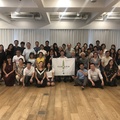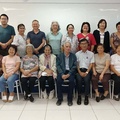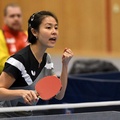In Brazil, it is not rare to find a Nikkei practicing one of the Japanese traditional arts. Calligraphy (shodo), tea ceremony (sado or chanoyu), or musical instruments like koto or shamisen are some examples.
However, it is difficult to find someone who does it all regularly. Furthermore, to be able to speak Japanese and have been ordained a Buddhist monk. Against these odds, meet Marcel Ueno, 33, descendant of third generation, whose family originates in the provinces of Fukuoka and Tokushima prefectures.
As a child, Marcel used to watch the not very numerous Japanese cartoons and TV series shown in Brazil. Even full of fantasy elements, choreographed fights and special effects, he was able to observe situations in which, somehow, Japanese traditional arts were practiced. Another way to find references was by reading manga. “My parents encouraged me, and I even looked for teachers, senseis. In adolescence and adult life, I began to have opportunities to find those people who could teach me,” he recalls.
At that time, the internet was in its early phase in Brazil. So, at 18, Marcel had to find schools or teachers through the old-fashioned way: newspapers and books of the Nikkei community.
Marcel graduated and works as an architect. As mentioned earlier, he practices shodo, shamisen, koto, and tea ceremony. “I have more practice in shodo, which I’ve studied for a longer time.”
The study of classical Japanese calligraphy is a special case. Through his teacher in Brazil, Marcel joined an association, the Shosai Shoken, based in Tokyo. Every month, he needs to send training sheets to the headquarters. “Through this association, I can also get classification. Just as in martial arts, there are graduations in shodo, just like the ‘kyu’ and ‘dan.’ I was able to apply for tests and recently got the title of professor assistant,” he explains.
The perpetuation of Japanese culture is a topic constantly discussed in the Japanese-Brazilian community. “I always had the desire that this [the practice of traditional arts] does not end. I do not know what the future holds, because many people have no interest. Even though, I notice that there is an emerging new generation that is becoming aware and interested,” says Marcel.
In São Paulo, there is a considerable offer of Japanese arts courses, which takes advantage of the popular social networks to become well known. It is remarkable that early levels have full classes, but few students in the most advanced ones.
“Since they are very difficult arts, it is hard to find someone who has the will and persistence to say ‘I will do this for about 10 years.’ I do not know if it’s because the Nikkei have education with Japanese influence, but also with the influence of Western culture, so they do not have the patience to polish the spirit to practice,” theorizes Marcel.
“The only activities I practice that have people of my age are koto and tea ceremony. In the others, the majority are older people,” he says. “One thing that made me sad was that, in the case of shamisen, many young people started classes, but I was the only one who continued. Everyone quit,” he laments.
Marcel thinks that a possible way to encourage young people to the practice of traditional arts requires a change of thinking. “There has to be, within the community, an awareness that these arts are not ‘something for old people.’ You must, of course, start with the classic in order to develop a contemporary thing. It is what I have seen in Japan today. In the case of architecture, for example. The contemporary architecture that preserves traces of the traditional Japanese architecture. We see a lot of this in the Japanese woodwork as well.”
For the future, Marcel considers to become a teacher himself. “Between Shodo and tea ceremony, I believe it is reachable. Despite being the art that I have been practicing for longer, shodo is the most difficult to transmit, since it is necessary to know how to write in Japanese,” he says.
Studying with older teachers and students is not a problem for Marcel. “I feel they are very pleased to have a younger person who is interested and attending classes,” notices Marcel, to whom the classes, although demanding, are quiet.
All his studies happen in Japanese. In addition to maintaining fluency in the language, Marcel highlights another benefit. “Because I learn these arts in Japanese, I also learn the Japanese manners, specially the master-disciple relationship. When shifting to Portuguese, it is inevitable that it will become something more relaxed, informal, then something will be lost,” he says.
Buddhism
In 2007, Marcel got a scholarship from JICA (Japan International Cooperation Agency) in Sapporo, Hokkaido, to study architecture.
“Coincidentally, near the JICA accommodation, I found a Buddhist temple of the same denomination that my family follows. Then I began to attend it,” he says. So he decided to become a monk. “I always accompanied my grandmother to do the prayers at the butsudan. Since an early age, I could read the sutra,” he recalls.
In order to be admitted, Marcel had to join the temple and get a letter of recommendation from a monk. He remained there from 2010 to 2011 and became a monk affiliated to the Jodo Shinshu Hongwanji-ha (Buddhism of Pure Land), whose headquarters are in Kyoto, but Marcel is registered in Sapporo.
“I attented a kind of technical school affiliated to Nishi Hongwanji. We had a schedule similar to a school in Brazil. Every morning, there was the morning prayer before we went to the classroom,” explains Marcel.
Regarding the students, there are two types of arrangements. One group of students lived in the lodges of the temple, while others rented nearby apartments. “Half of my time there, I lived at the lodge. As the cost was high, I decided to move. In the temple, laundry and feeding were included, so it was more expensive,” he explains. During his stay, he was able to devote himself exclusively to the studies, because he had planned to save money to that goal.
“The school was divided in several groups. Each group was responsible for the ‘presentation’ of the day. The task was leading the prayer chorus, reading the sutra. That group had to come up in advance to prepare, to dress, to be able to do the morning prayer. At the same time, it was practice for any special occasions. For example, when there was a celebration in the main temple, we did it as a form of training, under our master guidance,” he describes.
Currently, Marcel is not affiliated with any temple in Brazil. He keeps his practices at home and is still able to conduct some ceremonies. Just as he does with shodo, shamisen, koto, and tea ceremony.
© 2015 Henrique Minatogawa






